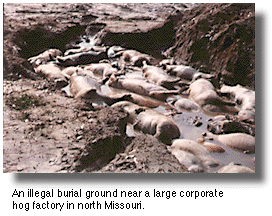|
Environmental and Human Health
Impacts of Factory Farms
National campaign for family farms
and the environment
by Bill Wenzel
Mount Horeb, Wisconsin
 Hogs produce two to four times as much raw waste as the average human. The 80,000 hogs raised by Premium Standard Farms (PSF) in Lincoln Township can generate as much waste as all the people in Jefferson City, Columbia, and Springfield, Missouri combined. Hogs produce two to four times as much raw waste as the average human. The 80,000 hogs raised by Premium Standard Farms (PSF) in Lincoln Township can generate as much waste as all the people in Jefferson City, Columbia, and Springfield, Missouri combined.
The manure is stored in open, earthen pits called lagoons. Factory farm owners would have people to believe that lagoons don't leak - that bacteria breaks down the animal waste and that the heavier sludge settles to the bottom of the lagoon creating an effective seal. The scientific evidence is to the contrary.
In Northampton County, North Carolina, Carroll's Foods installed monitoring wells on three of its hog farms in 1993 to test for groundwater contamination. During the course of the study the levels of ammonia nitrogen - a byproduct of urine - jumped from a normal level of two parts per million to 178 parts per million. Richard Maas, Director of the Environmental Quality Institute at the University of North Carolina, indicated that the only plausible conclusion was that the lagoons were leaking.
A study by North Carolina State University tested 11 "old lagoons" - seven years and older - and found that more than half were leaking moderately to severeIy, and that in some lagoons described as having little seepaqe the nitrate levels in the groundwater were three times the allowable level. Test wells were installed in three "new lagoons" and in two of those cases leaking began immediately.
The Minnesota Pollution Control Agency which has permitting authority over animal waste lagoons estimates that the average rate of leakage equals 500 gallons per acre per day.
Hog manure leaking from lagoons and running off farmland contaminates ground and surface waters with high concentrations of nitrates and phosphorous which impacts on environmental and human health.
A report by the North Carolina Department of Agriculture states that the biggest swine counties produce more nitrogen and phosphorous-rich manure than available land can absorb.
Infants exposed to high levels of nitrates, primarily through drinking water, have experienced "blue baby syndrome which reduces the bloods capability to carry oxygen. This condition has lead to infant death.
Excessive levels of phosphorous and nitrogen trigger algae blooms which are deadly to fish, animals and aquatic vegetation.
Farmworkers in factory farm livestock operations experience significantly higher rates of respiratory problems than the general public.
An American Lung Association study done in conjunction with the University of Iowa found that 70% of swine confinement workers experience one or more symptoms of respiratory illness or irritation and that 58% experienced chronic bronchitis - three times the rate of farmers in non-confinement situations.
Bill Wenzel of the Wisconsin Rural Development Center can be reached at (608) 437-5971.
|



 Hogs produce two to four times as much raw waste as the average human. The 80,000 hogs raised by Premium Standard Farms (PSF) in Lincoln Township can generate as much waste as all the people in Jefferson City, Columbia, and Springfield, Missouri combined.
Hogs produce two to four times as much raw waste as the average human. The 80,000 hogs raised by Premium Standard Farms (PSF) in Lincoln Township can generate as much waste as all the people in Jefferson City, Columbia, and Springfield, Missouri combined.